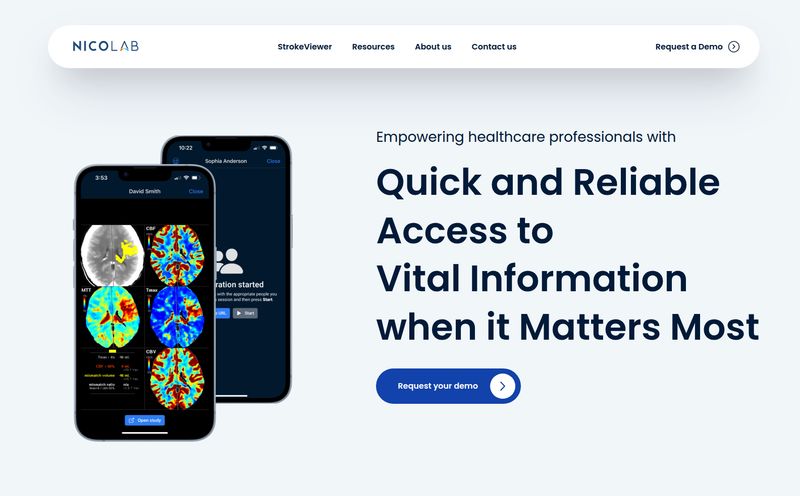Let me paint you a picture. You're in a meeting room, the creative energy is flowing. You, the designated whiteboard wizard, are frantically sketching out a complex user flow. Boxes, diamonds, arrows connecting everything… it’s a masterpiece of organized chaos. Everyone nods, snaps a blurry photo on their phone, and the meeting ends. Now what?
Now comes the part I've always dreaded. The part where you have to meticulously recreate that beautiful, free-flowing diagram in a tool like Visio, Lucidchart, or diagrams.net. It’s a soul-crushing, repetitive task that feels like translating poetry into binary. You spend an hour aligning boxes, wrestling with connectors, and typing out text you already wrote once. There has to be a better way, right?
Well, I think I might have found it. I recently stumbled upon a tool called Sketch2scheme, and honestly, I'm a little bit giddy about it. It promises to be the bridge between that messy whiteboard sketch and a clean, digital, and editable diagram. A magical translator for our professional doodles. But does it actually work?
So, What Exactly is Sketch2scheme?
Think of it as an AI-powered assistant whose only job is to save you from the drudgery of redrawing diagrams. You feed it a picture of your hand-drawn flowchart—whether it's on a napkin, a notepad, or a whiteboard—and it spits out a polished, digital version. No more starting from a blank canvas.
It's designed to understand the core components of a typical diagram. The AI is trained to recognize the different shapes (nodes), the lines that connect them (connections), and even the scribbled text inside those shapes. It’s not just a simple image trace; it actually interprets the structure of your diagram. That’s the key difference.
From Messy Sketch to Clean Scheme
The real magic is in the transformation. I’ve seen some of the examples, and it’s pretty darn impressive. It takes a sketch, with all its human imperfections and slightly skewed lines, and intelligently auto-arranges and aligns the elements. The result is a crisp, professional-looking scheme that you can actually use in a presentation or documentation without feeling embarrassed.
And you're not locked into their final product. This isn't a one-way street. You can edit the results directly using a visual editor or, for the more technical crowd, using Mermaid code. This is a huge win for developers who live and breathe Markdown.

Visit Sketch2scheme
#
The Good, The Bad, and The Nitty-Gritty
No tool is perfect, of course. After poking around, I've got some thoughts on where Sketch2scheme really shines and where you might need to temper your expectations. It's not a silver bullet, but it's a very, very shiny and useful tool.
#
What I Genuinely Liked
The biggest benefit is the most obvious one: it saves so much time. The hours I've personally sunk into recreating diagrams could probably be measured in weeks. Automating this is a massive win for productivity. It lets you stay in the creative flow of brainstorming without the looming dread of the digital transcription that awaits.
The flexibility of the export options is another major plus. You can grab a quick PNG or a scalable SVG for presentations. But the real game-changer for me is the compatibility with `diagrams.net` (the evolution of Draw.io) and Mermaid. It means you're not just getting a static image; you're getting a fully editable project file you can tweak and expand in tools you already use. That's smart.
A Few Things to Keep in Mind
Alright, let's talk about the elephant in the room: the credit system. Sketch2scheme isn't a free-for-all service. It operates on recognition credits. Each time you convert a diagram, it costs you a credit. Some might see this as a downside, and I get it. We're all used to the all-you-can-eat subscription model.
However, I see it differently. It's more of a pay-as-you-go model. If you only need to digitize a few diagrams a month, this is actually way more cost-effective than a monthly subscription you barely use. It puts you in control. For power users or teams, there's an Agency plan, but that one locks API access behind it, which is a bit of a bummer for smaller teams who might want to automate workflows without enterprise-level pricing.
Who is Sketch2scheme Really For?
I can see a few groups of people absolutely falling in love with this.
- Project Managers & Business Analysts: For mapping out process flows, user journeys, and organizational charts on the fly and quickly turning them into shareable assets.
- Software Developers: Brainstorming system architecture or logic flows on a whiteboard and getting a head start on documentation with a Mermaid export. This is huge.
- Students & Educators: Quickly digitizing study notes, mind maps, and complex scientific process diagrams.
- Consultants: Impressing clients by turning a workshop brainstorming session into a polished deliverable in record time.
Basically, if your workflow involves the phrase, “Okay, let me just draw it out for you,” then this tool is probably for you.
#
Let's Talk Money: The Pricing Breakdown
The pricing is refreshingly simple, which I appreciate. There are no confusing tiers with slightly different features designed to upsell you. It’s pretty straightforward.
| Plan | Price | What You Get |
|---|---|---|
| Regular | $3.99 | 10 recognition credits, access to all editors (Basic, Visual, Code), and multiple export formats. |
| Agency | $$ (Contact for Price) | Everything in Regular, plus raised or no limits on credits, and full API access. |
The Regular plan at $3.99 for 10 conversions feels like a no-brainer to try out. That's less than 40 cents a diagram. If it saves you even 15 minutes of work per diagram... well, the math speaks for itself. The Agency plan is more of a black box, typical for enterprise-focused offerings, but it's good to know there's an option for high-volume needs.
A Quick Comparison to the 'Old Way'
"Working on a diagram the usual way means starting from scratch, manually entering all labels, and spending ages arranging and aligning elements. Sketch2Scheme automates all of that."
That quote, paraphrased from their site, sums it up perfectly. The old way is comfortable, sure, but it's also incredibly inefficient. It introduces a tedious, low-value task right in the middle of a high-value creative process. This tool aims to eliminate that friction point entirely, keeping your momentum going from idea to implementation.
#
My Final Verdict
So, is Sketch2scheme the future of diagramming? Maybe not the entire future, but it's a significant and incredibly clever step in the right direction. It's not trying to replace your favorite diagramming tool; it's trying to be the perfect companion to it.
It respects the messy, wonderful, and very human process of sketching out ideas with a pen. It doesn’t ask you to change your brainstorming habits. It just offers a fantastically efficient shortcut for what comes next. For me, that’s more than just a cool feature; it’s a fundamental workflow improvement. And for less than the price of a fancy coffee, you can give it a try. I'd say it's definitly worth a shot.
Frequently Asked Questions about Sketch2scheme
- What kind of diagrams can Sketch2scheme recognize?
- It's optimized for flowcharts and other diagrams with clear nodes (shapes like boxes, circles, diamonds) and connectors (lines/arrows). Extremely complex or artistic diagrams might be a challenge, but for standard process flows, it works well.
- Do my recognition credits expire?
- The website doesn't explicitly state an expiration policy on the main page, but typically for credit-based systems, they are valid for a long period, if not indefinitely. It’s best to check their terms of service for the specifics.
- Is my data safe when I upload a sketch?
- Like any cloud-based tool, you should always be mindful of what you upload. For general business processes or non-sensitive information, it should be fine. I would, however, avoid uploading diagrams with confidential or proprietary data, as is standard practice for any third-party tool.
- Can I edit the text after the AI recognizes it?
- Yes! That's one of the best parts. Once it's converted, you get an editable diagram. You can fix any text misinterpretations, add more detail, and change the layout in their editor or after exporting to a tool like diagrams.net.
- What if the AI makes a mistake?
- AI isn't flawless. If it misinterprets a connection or a shape, you can easily correct it in the built-in visual editor before you finalize your export. It gives you a very solid first draft, not necessarily a pixel-perfect final version every single time.
Reference and Sources
- Sketch2scheme Official Website
- Sketch2scheme Pricing Page
- diagrams.net (formerly Draw.io)
- Mermaid.js Documentation



